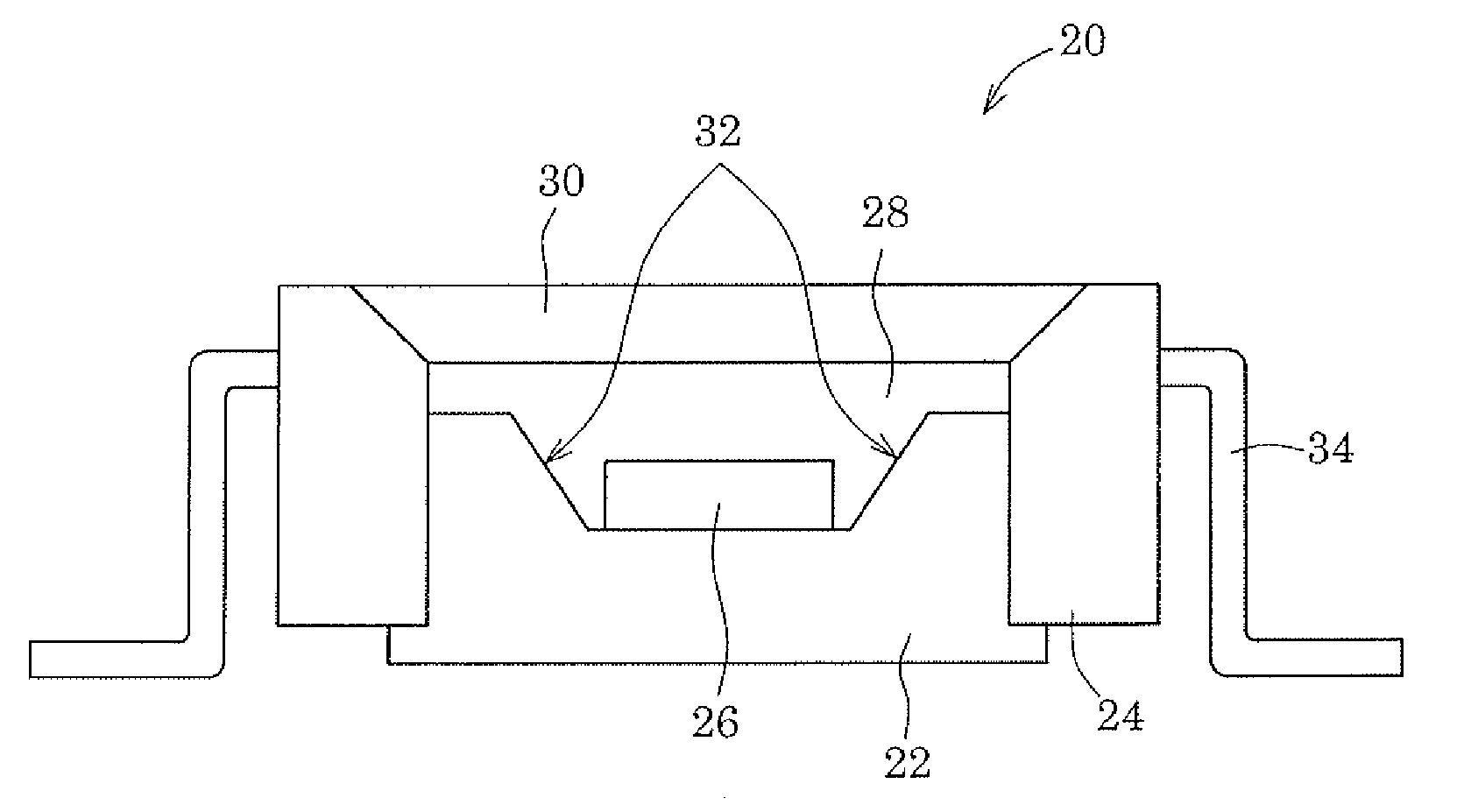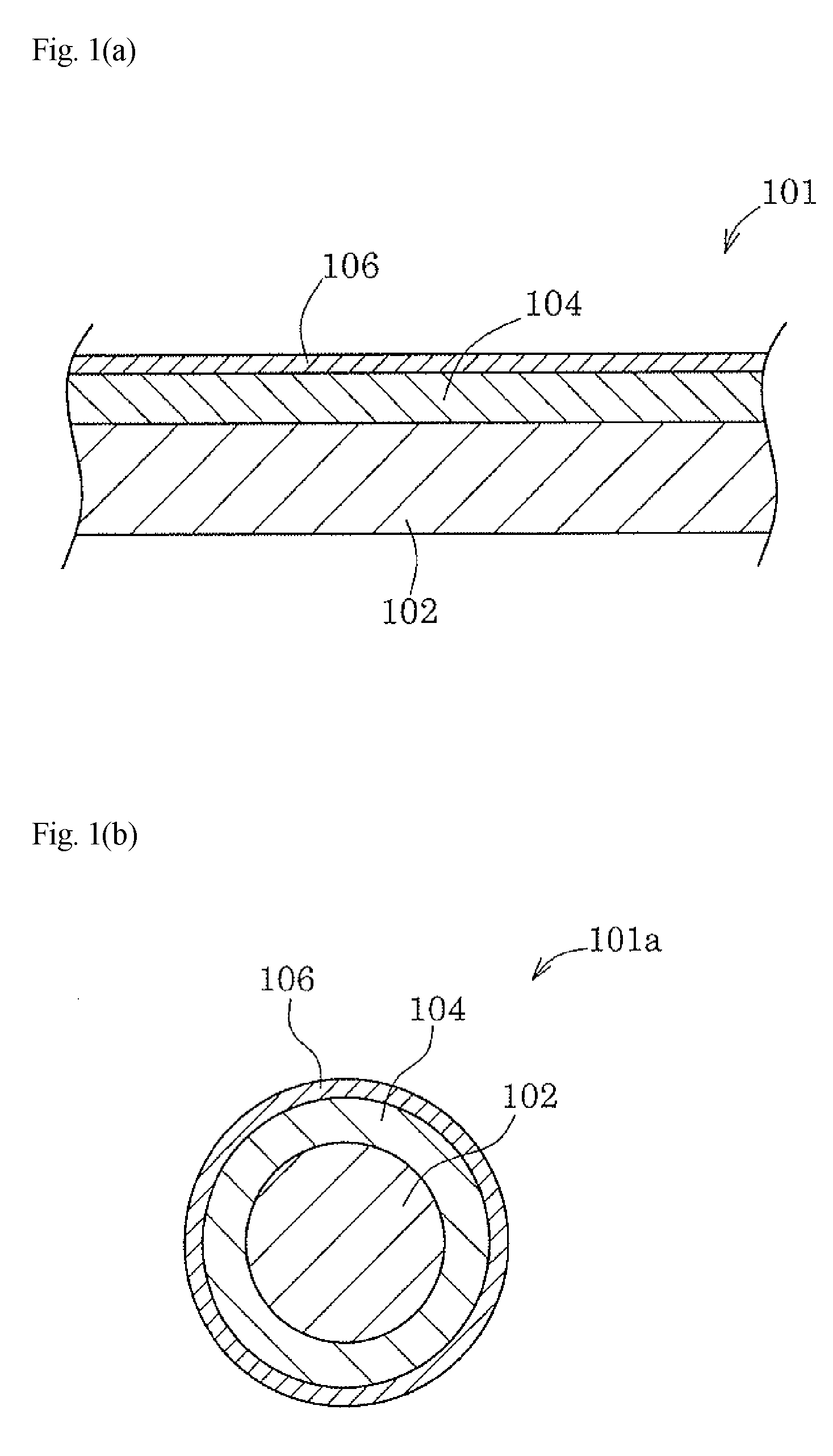Plating structure and method for manufacturing electric material
a technology of plating structure and manufacturing method, applied in the direction of incadescent envelope/vessel, transportation and packaging, coating, etc., can solve the problems of reducing the effect of preventing sulfurization, not necessarily achieving satisfactory effect, and reducing the reflectance of the layer, so as to avoid sulfurization and damage with time and temperature rise, high resistance, and low contact resistance
- Summary
- Abstract
- Description
- Claims
- Application Information
AI Technical Summary
Benefits of technology
Problems solved by technology
Method used
Image
Examples
experimental examples
Base Samples
[0061]As an equivalent of the plating base 102 shown in FIG. 1(a) or FIG. 1(b), a 1-cm square piece of a lead frame copper alloy strip (product name “EFTEC3” manufactured by Furukawa Electric Co., Ltd.) was used. A base sample was obtained by underplating one side of the piece with copper to a thickness of 1 μm, and subsequently silver-plating the underplated side to a thickness of 2 μm. This base sample was tin-plated, heat-treated, and the like in accordance with the following experimental levels.
[0062]L-1: blank (the base sample).
[0063]L-2: a tin layer with a thickness of 0.01 μm was formed on the silver surface of the base sample by flash plating.
[0064]L-3: a tin layer with a thickness of 0.01 μm was formed on the silver surface of the base sample by flash plating, and subsequently the sample was heat-treated at 300° C. for 10 seconds.
[0065]L-4: a tin layer with a thickness of 0.02 μm was formed on the silver surface of the base sample by flash plating.
[0066]L-5: a t...
example 1
[0098]A frame in the shape of the substrate 203 shown in FIG. 2 was silver-plated and tin-plated. As the material of the frame that serves as the base, a lead frame copper alloy strip (“EFTEC3” manufactured by Furukawa Electric Co., Ltd.) was used, and the frame was formed by stamping the lead frame copper alloy strip. The frame was subjected to degreasing treatment, was subsequently acid rinsed with 5% sulfuric acid, and was underplated with copper in a bright copper sulfate bath (200 g / L copper sulfate, 50 g / L sulfuric acid, and a 2 mL / L commercial brightening agent). The film of the copper underplating had a thickness of 1.0 μm. Subsequently, the frame was bright silver-plated to a thickness of 2 μm in a bright silver cyanide bath (35 g / L silver cyanide, 90 g / L potassium cyanide, and 10 g / L potassium carbonate). Further, the frame was tin-plated to a thickness of 0.01 μm in an alkanolsulfonate bath (18 g / L tin(II), 100 g / L free acid, and 10 mL / L semi-brightening agent), and was s...
example 2
[0099]A stainless (SUS304) sheet with a thickness of 1 mm and 1 cm square was used as the base, was subjected to degreasing treatment, was subsequently acid rinsed with 5% sulfuric acid, and was underplated with copper in a bright copper sulfate bath (200 g / L copper sulfate, 50 g / L sulfuric acid, and a 2 mL / L commercial brightening agent). The film of the copper underplating had a thickness of 1.0 μm. Subsequently, the sheet was bright silver-plated to a thickness of 2 μm in a bright silver cyanide bath (35 g / L silver cyanide, 90 g / L potassium cyanide, and 10 g / L potassium carbonate). Further, the sheet was tin-plated to a thickness of 0.01 μm in an alkanolsulfonate bath (18 g / L tin(II), 100 g / L free acid, and 10 mL / L of semi-brightening agent), and was subsequently heat-treated at 500° C. for 10 seconds. Thus a bright sheet was obtained. A sulfurization test gave a similar result to that of L-3 of Table 1.
PUM
| Property | Measurement | Unit |
|---|---|---|
| Length | aaaaa | aaaaa |
| Diameter | aaaaa | aaaaa |
| Nanoscale particle size | aaaaa | aaaaa |
Abstract
Description
Claims
Application Information
 Login to View More
Login to View More - R&D
- Intellectual Property
- Life Sciences
- Materials
- Tech Scout
- Unparalleled Data Quality
- Higher Quality Content
- 60% Fewer Hallucinations
Browse by: Latest US Patents, China's latest patents, Technical Efficacy Thesaurus, Application Domain, Technology Topic, Popular Technical Reports.
© 2025 PatSnap. All rights reserved.Legal|Privacy policy|Modern Slavery Act Transparency Statement|Sitemap|About US| Contact US: help@patsnap.com



